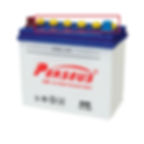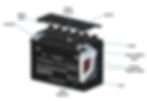AGM Vs Gel Battery Vs Flooded [Wet/Standard]
- Yakub Ansari
- Jul 4, 2021
- 5 min read
Updated: Jan 1, 2025
The most common types of Lead-acid batteries available are the Flooded [also known as wet type] type and Sealed type. Sealed-type batteries are also known as Valve-Regulated Lead Acid (VRLA) batteries. Both AGM and Gel batteries are types of VRLA [Sealed] batteries.

Lead Acid batteries are part of the rechargeable batteries family.
Flooded batteries also known as Wet Batteries are the most common ones, available in the whole world. Lead batteries are widely used for Home UPS batteries and Car Batteries. They can also be classified based on their application. For Example, Home UPS batteries are deep cycle and Car batteries are dual-purpose [Learn more about USP Battery Vs Car Battery]

What is a Flooded (Wet) Battery?
The flooded lead-acid (FLA) battery, invented in 1859, was the first rechargeable battery. After decades of refinement, it remains the primary choice for many applications. The battery plates are immersed in an electrolyte of dilute sulfuric acid, and removable caps in the lid allow the replacement of lost water.
Flooded Batteries can be easily identified by the float indicators or small yellow plugs
FLA batteries are cost-effective, rugged, and provide reliable performance when properly maintained. Because FLA batteries are not sealed, they must be kept in the proper orientation (upright) to avoid the spilling of electrolytes.
Due to the risk of spills, they cannot be shipped by air. During the charging process, FLA batteries consume water and release hydrogen gas, which must be properly vented to avoid potential fire hazards.
The water consumed during charging must periodically be replaced at a frequency that varies with the user profile. Although the introduction of single-point watering systems has reduced the overall effort to water FLA batteries, this periodic requirement means that these batteries are appropriate only in situations where regular maintenance can be assured.
With proper maintenance and charging, flooded batteries can provide years of reliable service in many applications. [Learn more about Flooded batteries...]

What is an AGM (Absorbed Glass Mat) Battery?
The AGM battery is a sealed battery that fits into the category of Valve-Regulated Lead Acid (VRLA) batteries. These batteries are designed so that hydrogen and oxygen are recombined within the battery, rather than being vented. A built-in valve will release excess gas in case of a severe overcharge.
An AGM battery is constructed by compressing a glass fibre mat between each plate. The glass mat holds electrolytes in place much like a sponge and helps support the plates.
This gives AGM batteries good resistance to shock and vibration. Since AGM batteries are sealed, they can be mounted on their sides if desired and ventilation requirements are much less demanding than with flooded batteries. They can be shipped by air if needed.
They have the ability to charge and discharge at high rates and perform well at low temperatures.
It is very important that AGM batteries not be severely overcharged, as this will cause the battery to rapidly dry out. The selected charger must specifically have an AGM setting to avoid damaging the battery.
What is a GEL Battery?
A Gel battery is another type of VRLA battery, and like the AGM, is sealed. Although the basic internal construction of a Gel battery is similar to that of the flooded battery, the electrolyte has been immobilized by the addition of a thickening agent, taking on the look and consistency of petroleum jelly.
Like the AGM, it can be mounted on its side and doesn’t release hydrogen during normal operation. Gel batteries have a higher initial cost, and typically don’t work as well in higher power applications.
In deep-cycle applications, they will generally outlast an AGM battery, unless the AGM has been designed for deep cycling. Like the AGM, the selected charger must have a specific Gel setting to avoid overcharge damage.
Additionally, the charger and charge algorithm should support temperature-compensated charging. Since Gel batteries are resistant to spills and leakage, they can also be shipped by air.

Flooded [Wet] Vs AGM Vs Gel Battery
Now that we’ve described the basic categories of lead-acid batteries, let’s take a look at the various performance characteristics that may come into play as you select the proper battery for your application. Sealing/Gas Release As previously noted, the process of charging a lead-acid battery generates hydrogen and oxygen.
In a flooded battery, these gases are released into the external atmosphere. In a VRLA battery [AGM/GEL], these gases are internally recombined and stay within the battery.
In some applications, the required ventilation requirements for a flooded battery are not feasible. In others, the possibility of acid leaks during service or due to a broken case is unacceptable.
This guides the selection process to one of the VRLA types.
Maintenance
Flooded batteries require regular water replacement to continue to perform effectively. If regular maintenance cycles to add water are impractical, such as in remote, unstaffed installations, then one of the VRLA technologies [AGM/GEL] may be more desirable.
Note that even though VRLA batteries don’t require watering, periodic cleaning and re-torquing of connections is still required.
Deep-Cycle Capability
Flooded and VRLA [AGM/GEL] batteries, when designed for deep cycling, have very good cycling capability. While flooded types typically have very good cycling, they require proper maintenance in order to achieve long cycle life.
VRLA types do not require maintenance but do require proper charging in order to achieve long cycle life.
Recharge Time
FLA batteries need a higher amount of overcharge than VRLA [AGM/GEL] types to avoid a harmful effect known as stratification, so this can extend FLA charge times.
However, charge time is more dependent upon the depth of discharge and the size (power) of the charger being used.
Self-Discharge
Self-discharge is the capacity loss that occurs within a battery even when it is not connected to a load. How quickly a battery self-discharges is related to temperature, whereas warmer temperatures mean the battery will self-discharge quicker.
As a result of parasitic chemical reactions within the battery, the self-discharge rate of VRLA batteries is much lower than that of FLA batteries. This can be an important constraint if batteries need to be stored for long periods of time.
Low-Temperature Performance
Some applications require batteries to perform well even at temperatures well below 0°C (32°F). AGM batteries have the best low-temperature performance of the three technologies discussed here.
Energy Density
Within the lead-acid family, FLA batteries have the most capacity for a given size or weight. When you need the most Ah possible in a size-constrained location, then flooded batteries are likely your best choice.
Power Density
AGM batteries are best suited in applications where high discharge currents are needed. Gel batteries are more suited to longer, lower current cycles.
At high rates of discharge, AGM batteries deliver more of their theoretical capacity than do FLA batteries.
Round-Trip Efficiency
Whenever energy is converted and stored, there will always be an efficiency penalty. The round-trip efficiency, or the percentage of energy that a battery delivers compared to the energy that it took to charge it, can be particularly important in certain applications.
Flooded batteries typically have round-trip efficiencies of 70-80%, while AGM and GEL batteries will be in the range of 80-90%.
Cost
Due to the cost of materials and processing, FLA batteries are generally the least expensive, while Gel batteries are the most expensive. AGM batteries will fall somewhere in between.
Summary
As this paper has described, a wide variety of factors can influence the selection of the proper lead-acid battery technology. In some instances, one particular factor may dominate the decision, while in others a mix of performance attributes may determine which technology will be the best.
Also Read: Why tubular batteries are expensive.






























![What is a 200Ah battery? [for beginner]](https://static.wixstatic.com/media/80a440_090723acf3bf4c29b108def7e41ff1dc~mv2.jpg/v1/fill/w_250,h_250,fp_0.50_0.50,q_30,blur_30,enc_avif,quality_auto/80a440_090723acf3bf4c29b108def7e41ff1dc~mv2.webp)
![What is a 200Ah battery? [for beginner]](https://static.wixstatic.com/media/80a440_090723acf3bf4c29b108def7e41ff1dc~mv2.jpg/v1/fill/w_70,h_70,fp_0.50_0.50,q_90,enc_avif,quality_auto/80a440_090723acf3bf4c29b108def7e41ff1dc~mv2.webp)
![What is mean by a 150Ah battery? [For Beginner]](https://static.wixstatic.com/media/80a440_9efb8f252a1e40209620c9c5780c0f81~mv2.jpg/v1/fill/w_254,h_250,fp_0.50_0.50,q_30,blur_30,enc_avif,quality_auto/80a440_9efb8f252a1e40209620c9c5780c0f81~mv2.webp)
![What is mean by a 150Ah battery? [For Beginner]](https://static.wixstatic.com/media/80a440_9efb8f252a1e40209620c9c5780c0f81~mv2.jpg/v1/fill/w_71,h_70,fp_0.50_0.50,q_90,enc_avif,quality_auto/80a440_9efb8f252a1e40209620c9c5780c0f81~mv2.webp)



